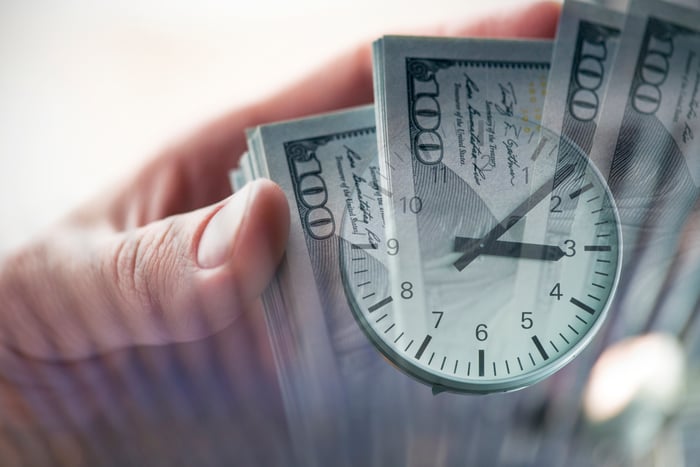For more than a century, there's arguably been no better investment vehicle than the stock market. Though cryptocurrencies have had their time in the spotlight over the past couple of years, it's hard to overlook the stability of a greater than 11% average annual total return, including dividends paid, in the benchmark S&P 500 since 1980.
I'm absolutely counting on stocks to play a key role in building a sufficient nest egg to fund my retirement. While I currently have positions in close to three dozen stocks, there are only a few that I expect will make me wildly rich by retirement.

Image source: Getty Images.
Teladoc Health
Although it's been a dud of a performer in 2021, telehealth platform Teladoc Health (TDOC -1.99%) is a holding I fully expect to deliver 10X (or greater) returns by the time I'm ready to enjoy retirement.
While some folks would opine that Teladoc was lucky to be in the right place at the right time when the pandemic struck, I'd contend that they're not looking at the bigger picture. For instance, in the six years leading up to the pandemic, Teladoc's average annual sales grew by 74%. These figures don't indicate a fad brought on by the pandemic. They represent an easily identifiable shift in how personalized care is being administered.
What Teladoc offers is an improvement up and down the treatment chain. Virtual visits are more convenient for patients, and they're especially helpful for physicians who are trying to keep tabs on people with chronic illnesses. The Teladoc platform allows for seamless data-sharing between patients and physicians. Most importantly, virtual visits should lead to improved patient outcomes, which ultimately means less money out of the pockets of insurers.
Teladoc's other "secret weapon" is applied health signals company Livongo Health, which it acquired late last year. Livongo leans on artificial intelligence to send nudges to its chronic-care members to change their behaviors for the better. Though it has a big focus on diabetes at the moment, its services will also encompass hypertension and weight management. Thus, Livongo's patient pool should include a large swath of the U.S.
With Teladoc slated to grow at 25% to 30% annually through 2024, the company looks to still be in the early innings of transforming the healthcare space.

Image source: Getty Images.
SSR Mining
In a market ruled by growth stocks, my largest holding, and the single-best return I've had as an investor, is gold-and-silver miner SSR Mining (SSRM -2.22%). I'm currently higher by 1,235% from my cost basis.
To state the obvious, you don't buy a mining stock unless you believe in the appreciation potential of the metal it's digging out of the ground. The lustrous yellow metal should continue to benefit from historically low lending rates in the near-term, as well as rapidly rising inflation. With few avenues to generate safe income, the gold is a good bet to move higher.
But owning SSR Mining is about more than just hoping gold and silver (a majority of the company's revenue comes from mining gold) head higher.
Last year, SSR transformed itself by completing a merger of equals with Turkey's Alacer Gold. This brought SSR's three producing assets (the Marigold and Seabee gold mines and silver-focused Puna Operations) under one umbrella with Alacer's high-efficiency Copler gold mine. This merger nearly double production, all while maintaining SSR's top-notch balance sheet, which sports over $500 million in net cash. In fact, things have been so good for SSR Mining that it instituted a $150 million share repurchase program and a $0.20 base annual dividend.
SSR Mining isn't going to drop jaws with its growth, but it's arguably the greatest value among gold stocks on the basis of its future cash flow.

Image source: Getty Images.
Lovesac
Also from the annals of "industries I didn't think would fund my retirement" is furniture stock Lovesac (LOVE 1.19%). Unlike SSR Mining, which I've owned for a long time, Lovesac was added right around the coronavirus crash.
Typically, when I type the phrase "furniture stock," my eyes droop a bit with boredom. That's because most furniture companies operate brick-and-mortar stores and rely on foot traffic to move the third-party manufactured furniture they've purchased wholesale. It's a cyclical and stodgy operating model that Lovesac has been more than happy to disrupt.
Lovesac's big differentiator is its furniture. While it was originally known for its beanbag-style chairs, known as sacs, about 85% of its revenue these days comes from modular couches known as sactionals. The modular design allows buyers to rearrange this furniture dozens of different ways, which means it'll fit most living spaces. Sactionals also have around 200 machine-washable cover options, therefore the theme or color scheme of any home can be matched. And for you ESG investing fans, recycled plastic water bottles are used to make the yarn for these covers.
Lovesac is also running circles around the stodgy furniture industry with its omnichannel sales platform. During the pandemic, the company shifted a significant portion of its sales online. When coupled with pop-up showrooms and showroom partnerships, Lovesac has been able to drive sales while keeping its overhead quite low.
With Lovesac pushing to recurring profitability well ahead of Wall Street's forecast, I'm excited to watch this innovator grow.

Image source: Getty Images.
Bark
If there's an industry investors simply shouldn't bet against, it's anything to do with companion animal spending. That's why I'm expecting Bark (BARK 0.47%) to fetch me a lifetime of financial freedom. As the company's name implies, Bark is a product-and-service-oriented company for dogs.
Just to give you some idea of how powerful the pet industry can be, data from the American Pet Products Association shows that year-over-year expenditures haven't declined in over a quarter of a century. The dot-com bubble, financial crisis, and pandemic couldn't slow pet owners' desire to keep their furry family members happy and healthy. As someone who spent on a fortune on his recently passed dachshund, I can attest to this willingness to do whatever is necessary to make your pet's finite existence as great as possible.
Enter Bark, stage left. This fairly new company, from a public listing perspective, offers a number of growth attributes that have me salivating. For one, nearly 90% of its sales are derived from direct-to-consumer subscriptions. As a general rule, subscriptions generate highly predictable cash flow with low overhead, and they have a tendency to keep users loyal to a service. In Bark's case, the company has consistently generated gross margins of 58% to 60%, and its subscriber count has catapulted from less than 1 million to 2.1 million in under two years.
Equally exciting is Bark's innovation. Last year, the company introduced Bark Home, a one-stop shop for basic accessories like beds and collars, and Bark Eats, a personalized service that helps owners craft a dry food diet delivered to their pooch. Adding new services can broaden the company's audience and create add-on opportunities that lift margins.
Bark will require some patience, but I believe it can be a 10X winner over the long haul.

Image source: Pinterest.
The fifth and final stock I believe can make me wildly rich by retirement is social media platform Pinterest (PINS 0.49%). Similar to a few other companies here, I piled into Pinterest during the coronavirus crash.
Like Teladoc, skeptics have had a field day with Pinterest this year. Naysayers point to two consecutive sequential quarterly declines in the company's monthly active user (MAU) count as a sign that Pinterest is in trouble. While its MAU growth has slowed over the past couple of quarters as vaccination rates have risen and life in some countries has normalized a bit, the company's three-year and five-year MAU growth trajectory are still within historic norms.
The bigger story here is how effective Pinterest has been at monetizing its MAUs. Even though year-over-year MAU growth came in at less than 1% in the September-ended quarter, average revenue per user was up 37% globally and 81% internationally. This tells us advertisers are willing to pay a lot more to reach Pinterest's potentially motivated shoppers.
The Pinterest platform is arguably the perfect model for advertisers. Instead of guessing what users like, the entire premise of Pinterest is to show the world what things, places, and services a person is interested in. This makes it incredibly easy for Pinterest to serve as the e-commerce middleman to connect motivated users with merchants who can meet their interests.
Pinterest is a profitable, early stage growth story that I can only hope doesn't get acquired.





